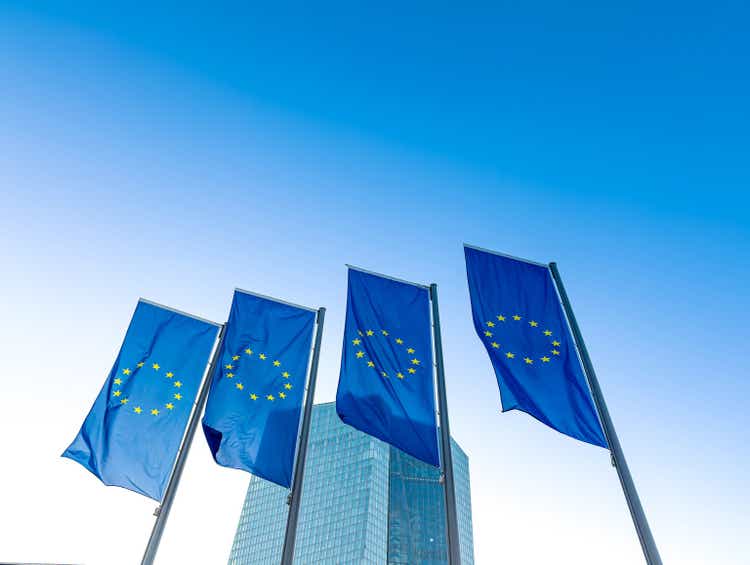littleclie
By Carsten Brzeski, Global Head of Macro
Today’s decisions
The European Central Bank has kept policy rates unchanged but slightly changed its communication. The policy statement signals that the end of rate hikes is here.
The removal of the phrase “inflation is expected to remain too high for too long” is a clear dovish signal. At the same time, however, the statement that “rates will be set at sufficiently restrictive levels for as long as necessary” is still in the official communication, and this suggests that the dovish shift is still a very small one. The ECB also announced a very gradual phasing out of the reinvestments under the Pandemic Emergency Purchase Programme (PEPP) in the second half of 2024. It is the timing and not the PEPP decision itself which came as a slight surprise.
ECB’s take on growth and inflation
Despite their dismal track record, the ECB’s staff projections will play an increasingly important role again over the coming months when deciding on whether or not to start cutting interest rates. Today’s forecasts show headline inflation at 5.4% in 2023, 2.7% in 2024, 2.1% in 2025 and 1.9% in 2026. We saw a downward revision for 2023 and 2024.
Underlying inflation forecasts, however, were slightly revised upwards to 5% in 2023, 2.7% in 2024, 2.3% in 2025 and 2.1% in 2026. GDP growth is expected to come in at 0.6% in 2023, 0.8% in 2024, and 1.5% in both 2025 and 2026. These forecasts defend an end to the current rate hike cycle – but definitely do not defend aggressive rate cuts next year.
According to the ECB, the risks to growth are still tilted to the downside, while there is still no risk balance for inflation.
Lagarde’s comments during the press conference
During the press conference, ECB President Christine Lagarde – still visibly recovering from Covid-triggered bronchitis – pushed back against recent market pricing of aggressive rate cuts in 2024. “We should absolutely not lower our guard”, she stated, later adding “We definitely did not converse rate cuts today.”
Why? In the ECB’s own models, the recent market pricing (with dropping interest rates across the board) came after the cut-off date of the recent forecasts and would currently yield higher inflation forecasts. So, if anything, the irony is that the recent easing of financial conditions would actually force the ECB to delay any rate cuts for longer.
Lagarde also emphasised the importance of domestic inflation, which according to her had not yet come down and was strongly affected by wage developments next year. However, when asked whether she would confirm her earlier statement that there wouldn’t be any rate cuts over the next quarters, the question remained unanswered. Whether or not this was deliberate remains unclear. When asked about the current market pricing of six rate cuts next year, Lagarde dodged the question.
Dovish shift but no rate cut on the radar screen (for now)
Today’s ECB meeting marks the end of the current rate hike cycle and was the first tentative step towards more dovishness to come. After today’s meeting, however, it should also be clear that the end of a hiking cycle does not imminently direct to a cutting cycle. This is why we still think that the ECB’s road to rate cuts will be longer than markets had been pricing in during the last two weeks. In fact, it is difficult to see how the central bank could deduce on a full U-turn on policy rates only on the back of a few weaker-than-expected inflation prints without headline inflation falling below 2% and longer-term inflation forecasts still being at around 2%.
The ECB’s forecasting mistakes of the past are probably an almost automatically built-in brake on premature and large-sized rate cuts. We think that it would necessitate a sharper economic downturn and/or inflation sustainably falling below 2% to see the central bank cutting rates by as much as the currently priced in 150bp. We think that it will first want to see the next round of the Bank Lending Survey and wage settlements in the first quarter of 2024 before even discussing rate cuts. Today’s ECB meeting confirmed our base case scenario of a gradual shift towards full dovishness with rate cuts starting in June.
Content Disclaimer: This publication has been prepared by ING solely for information purposes irrespective of a particular user’s means, financial situation, or investment objectives. The information does not constitute investment recommendation, and nor is it investment, legal, or tax advice, or an offer or solicitation to purchase or sell any financial instrument. Read more.
Editor’s Note: The summary bullets for this article were chosen by Seeking Alpha editors.



